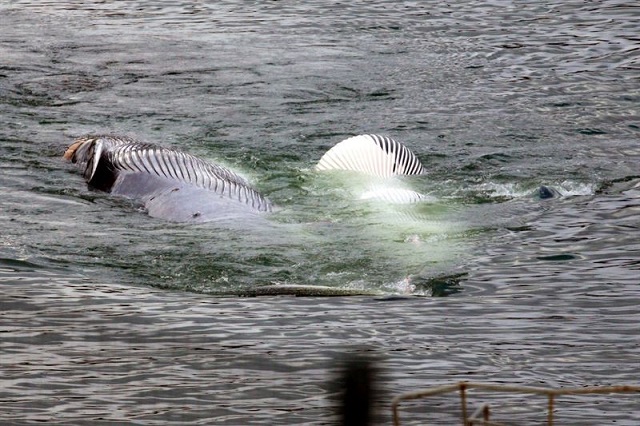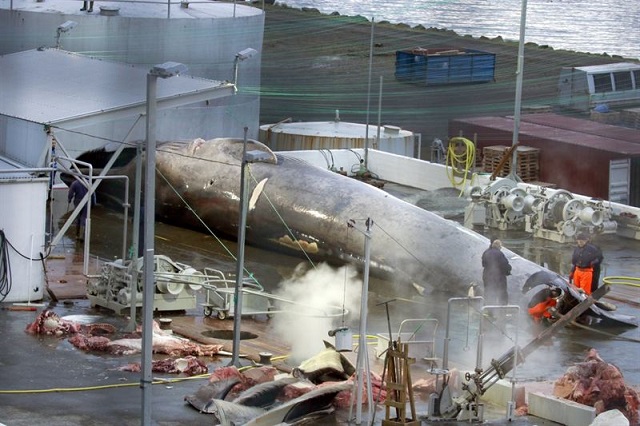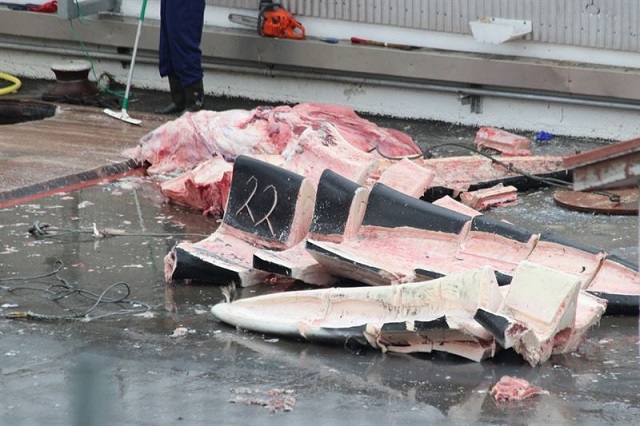[Updated] Sea Shepherd: Icelandic Whalers Slaughter Blue Whale
Sea Shepherd volunteers monitoring the Hvalur hf whaling station in Hvalfjordur, Iceland, claim to have documented the slaughter of an endangered Blue whale on the night of July 7.
The organization says this is the 22nd endangered whale killed for export to Japan by Kristján Loftsson’s commercial whaling company since June 20, 2018.
Although the first 21 whales killed were Fin whales – which the Icelandic government has permitted Loftsson’s company to slaughter despite an international moratorium on whaling and the endangered status of the Fin whale – they do not have any legal authority to kill endangered Blue whales, even within Iceland, alleges Sea Shepherd.
However, according to BBC News, the company says it is certain that the animal it has killed is not a blue whale but a hybrid. "I am absolutely confident that it's a hybrid," said Loftsson. "To mistake a blue whale for a fin whale is impossible. This whale has all the characterisations of a fin whale in the ocean. There are a lot of blue whales off the Iceland coast, when we see the blows and sail to it, and we realise it is a blue and then we leave it and go and look for fin whales."
No other nation, not even Japan or Norway, slaughters Fin whales, and there had not been a Blue whale harpooned for the last 50 years until this one. Blue whales and Fin whales are protected by the Convention on International Trade in Endangered Species (CITES).
Blue whales reach up to 33 meters (108 feet) in length, and have been protected by the International Whaling Commission since 1966, after uncontrolled and illegal commercial whaling left their populations on the brink of extinction. Like fin whales, they are listed by the IUCN as endangered, and with an estimated global population of between 10,000 - 25,000 individuals. Prior to the catastrophic commercial whaling of the 20th century it is estimated that there were in the region of a quarter of a million blue whales, but their populations crashed in the 1950s and 60s.
Loftsson’s whaling station crew posed for photos next to and on top of the whale.
Photographs and video taken by the Sea Shepherd UK team near the whaling station allowed them to examine the species identifying indicators of skin color/pattern, baleen color, dorsal fin shape and tail stock. According to several scientific experts specializing in whale identification contacted by Sea Shepherd, the whale was without question a Blue whale.
"While I can't entirely rule out the possibility that this is a hybrid, I don't see any characteristics that would suggest that. From the photos, it has all the characteristics of a Blue whale; given that - notably the coloration pattern - there is almost no possibility that an experienced observer would have misidentified it as anything else at sea," said Dr. Phillip Clapham, NOAA Alaska Fisheries Science Centre.
Sea Shepherd Founder Captain Paul Watson is appealing to Icelandic authorities to stop the whaler from further hunting. He said: “I have viewed plenty of Blue whales on the surface, dived with them beneath the surface in West Australia, off the coast of California, in the Southern Ocean and in the waters off Newfoundland. I know a Blue whale when I see one, and this whale slaughtered by Kristján Loftsson is a Blue whale.”
Sea Shepherd has had crew on the ground since the slaughter of whales began on June 20. Their aim is that every whale will be documented for the entire Fin whaling season.
Humane Society International has voiced it's outrage at the slaughter. Humane Society International's Senior Marine Scientist, Mark Simmonds OBE, believes the whale to be a juvenile blue whale or, conceivably, a rare fin whale-blue whale hybrid. Simmonds, said: "This terrible incident comes as Japan is rumoured to be planning an attempt to overturn the global moratorium on commercial whaling, and clearly speaks to how utterly inappropriate it is for countries to even contemplate allowing a large-scale return to this grossly inhumane and haphazard industry. Iceland's whaling is rogue and archaic and should command diplomatic criticism at the highest levels.”



